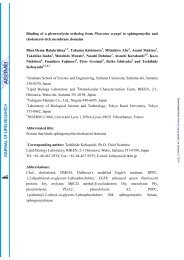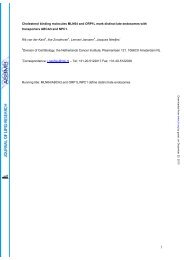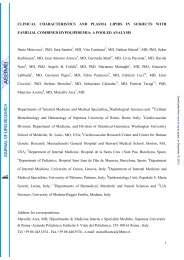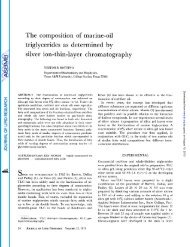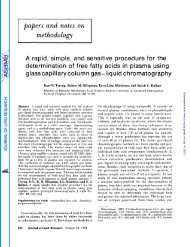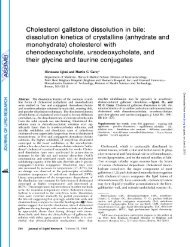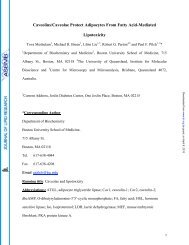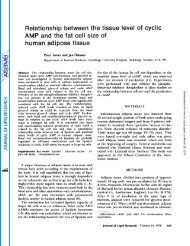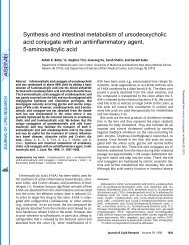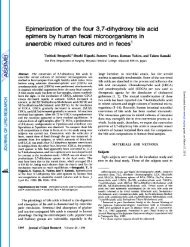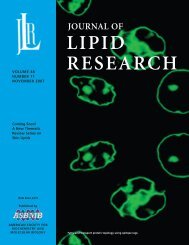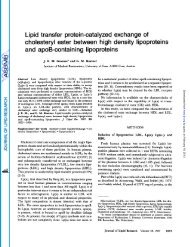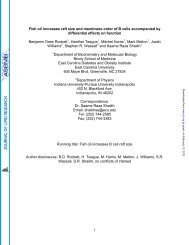a LDL lowering by - The Journal of Lipid Research
a LDL lowering by - The Journal of Lipid Research
a LDL lowering by - The Journal of Lipid Research
You also want an ePaper? Increase the reach of your titles
YUMPU automatically turns print PDFs into web optimized ePapers that Google loves.
0.16<br />
0.12<br />
0.08<br />
0.04<br />
0.00<br />
0.16<br />
0.1 2<br />
0.08<br />
0.04<br />
0.00<br />
I<br />
LOW CHOLESTEROL<br />
HIGH CHOLESTEROL<br />
CNT PE GG PSY<br />
Fig. 3. Receptor-dependent (open bar) and receptorindependent<br />
(hatched bar) <strong>LDL</strong> turnover rates <strong>of</strong> guinea pigs fed control (CNT),<br />
pectin (PE), guar gum (CC), and psyllium (PSY) diets with low<br />
cholesterol (0.04%)(upper panel) and high cholesterol (0.25%)(lower<br />
panel). Each bar represents the mean f SD <strong>of</strong> 5-8 animals; *represents<br />
significantly different from the control diet. Two-way ANOVA indicated<br />
that receptor-independent FCR was significantly higher in animals<br />
fed the low cholesterol diets (P < 0.05).<br />
balance as this organ is responsible for the absorption<br />
<strong>of</strong> dietary and biliary cholesterol and for the reabsorption<br />
<strong>of</strong> bile acids. Further, as the absorption <strong>of</strong> cholesterol<br />
through the small intestine is a linear function <strong>of</strong><br />
its concentration in the lumen (39), it is expected that<br />
animals fed HC diets will have increased delivery <strong>of</strong><br />
cholesterol to the liver through chylomicron remnants<br />
as is the case in the control guinea pigs. <strong>The</strong>refore, it is<br />
not surprising that the effects <strong>of</strong> fiber in the gastrointestinal<br />
tract will be influenced <strong>by</strong> the amount <strong>of</strong> dietary<br />
cholesterol.<br />
<strong>The</strong> present studies demonstrated that the significant<br />
depletion <strong>of</strong> hepatic cholesterol pools induced <strong>by</strong> nonstarch<br />
polysaccharides was due to decreases in cholesterol<br />
absorption and alterations in the enterohepatic<br />
circulation <strong>of</strong> bile acids as manifested <strong>by</strong> the up-regulation<br />
<strong>of</strong> hepatic cholesterol 7a-hydroxylase, the regulatory<br />
enzyme <strong>of</strong> bile acid synthesis. <strong>The</strong> fiber sources<br />
evaluated in these studies had different actions possibly<br />
associated with their chemical structures and their physicochemical<br />
properties. Similar to the present results, PE<br />
although <strong>of</strong> low viscosity has been found to reduce<br />
cholesterol absorption in animal and human studies (40,<br />
41). This capacity <strong>of</strong> pectin to reduce cholesterol absorption<br />
and its possible interruption <strong>of</strong> the enterohepatic<br />
circulation <strong>of</strong> bile acids, as suggested in the present<br />
investigation <strong>by</strong> the up-regulation <strong>of</strong> cholesterol 7a-h~droxylase,<br />
resulted in a significant reduction 4f hepatic<br />
free and esterified cholesterol pools especially in guinea<br />
pigs fed the PE-HC diet compared to animals fed HC<br />
with GG or PSY. PSY effects in <strong>lowering</strong> hepatic cholesterol<br />
were mostly due to interruption <strong>of</strong> enterohepatic<br />
circulation <strong>of</strong> bile acids as suggested <strong>by</strong> the observed<br />
increases in 7a-hydroxylase activity as no effects on<br />
cholesterol absorption were observed in agreement with<br />
clinical and animal studies (2, 42). <strong>The</strong> effects <strong>of</strong> GG in<br />
the small intestine are harder to interpret although a<br />
decrease in cholesterol absorption was observed in animals<br />
fed GG with high cholesterol diets. However, no<br />
effects <strong>of</strong> GG in cholesterol 7a-hydroxylase activity were<br />
detected although studies in the rat (14) and in humans<br />
(4) do suggest that GG increases bile acid excretion. <strong>The</strong><br />
primary mechanisms involved in reducing hepatic cholesterol<br />
concentrations are strongly correlated with the<br />
resulting cholesterol-<strong>lowering</strong> effects and it would appear<br />
from these results that bile acid excretion has a<br />
more potent effect in determining hepatic cholesterol<br />
concentrations in animals fed HC diets, as the lowest<br />
concentrations <strong>of</strong> hepatic cholesterol were observed in<br />
the PE group that had the highest enzyme activity while<br />
GG had the highest hepatic cholesterol concentrations<br />
and cholesterol 7a-hydroxylase activity was not different<br />
from the control. For animals fed GG-LC, the primary<br />
mechanisms <strong>of</strong> hepatic cholesterol-<strong>lowering</strong> were not<br />
evident in the present study as no effects <strong>of</strong> GG on<br />
cholesterol absorption or increased activity <strong>of</strong> cholesterol<br />
7a-hydroxylase were detected. It is possible that a<br />
combination <strong>of</strong> multiple mechanisms including the ones<br />
evaluated in this experiment could have taken place but<br />
were not identified under the present experimental<br />
conditions.<br />
Fiber effects on hepatic cholesterol metabolism and<br />
plasma cholesterol levels<br />
It is well known that the liver plays a major role in the<br />
levels <strong>of</strong> circulating <strong>LDL</strong> through the regulation <strong>of</strong><br />
V<strong>LDL</strong> synthesis and <strong>LDL</strong> catabolism <strong>by</strong> the apoB/E<br />
receptor (43). <strong>The</strong> decreases in hepatic cholesterol concentrations,<br />
specifically in the free pool, induced <strong>by</strong> PE,<br />
GG, and PSY in animals fed the LC diets resulted in an<br />
up-regulation <strong>of</strong> <strong>LDL</strong> receptors as indicated <strong>by</strong> the faster<br />
plasma total and receptor-mediated <strong>LDL</strong> turnover;<br />
these observations are in agreement with prex 'ious '<br />
reports<br />
<strong>of</strong> increased <strong>LDL</strong> binding to hepatic membranes<br />
(9-12). Animals fed the LC diets independent <strong>of</strong> the<br />
non-starch polysaccharide source had a higher contribu-<br />
Downloaded from www.jlr.org <strong>by</strong> guest, on August 28, 2013<br />
FrmandPz Dietary fiber and mechanisms <strong>of</strong> plasma <strong>LDL</strong> <strong>lowering</strong> 2401



